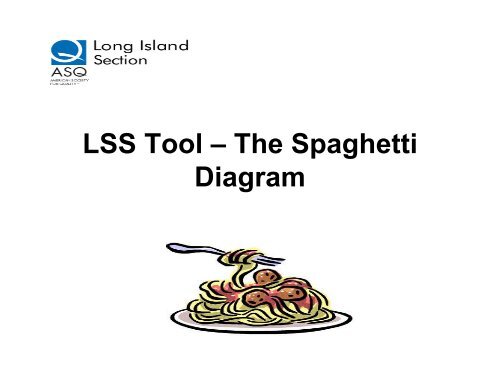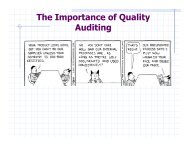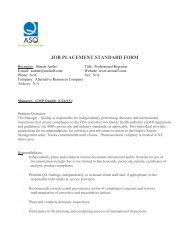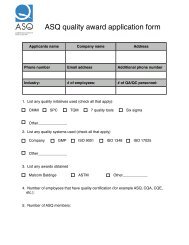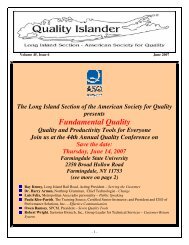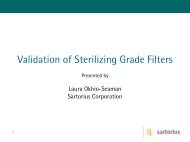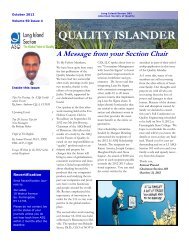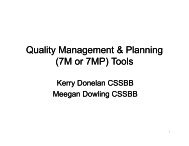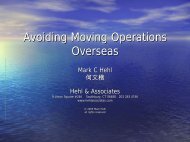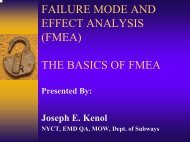LSS Tool â The Spaghetti Diagram - ASQ Long Island Section
LSS Tool â The Spaghetti Diagram - ASQ Long Island Section
LSS Tool â The Spaghetti Diagram - ASQ Long Island Section
You also want an ePaper? Increase the reach of your titles
YUMPU automatically turns print PDFs into web optimized ePapers that Google loves.
<strong>LSS</strong> <strong>Tool</strong> – <strong>The</strong> <strong>Spaghetti</strong><br />
<strong>Diagram</strong>
Agenda<br />
• What is a <strong>Spaghetti</strong> <strong>Diagram</strong><br />
• Uses of a <strong>Spaghetti</strong> <strong>Diagram</strong><br />
• Examples of a <strong>Spaghetti</strong> <strong>Diagram</strong><br />
• How to put together a <strong>Spaghetti</strong> <strong>Diagram</strong><br />
• <strong>Spaghetti</strong> Exercise<br />
• Questions
What is a <strong>Spaghetti</strong> Chart<br />
• a.k.a “Physical Process Map”, “Point-to-Point Flow Chart”, or<br />
“Work-flow <strong>Diagram</strong>”<br />
• Used to Graphically Depict <strong>The</strong> Movement of the Product or<br />
Documents (or people!) through a Process<br />
An An Illustration of of a System’s Inefficiency
<strong>Spaghetti</strong> Chart to Identify Waste<br />
• Differ from Detailed Process Maps and other Value Stream Maps<br />
–Do not require sequential process steps<br />
–Seek to highlight wasted motion<br />
–Built around specific work area layouts<br />
• Construction:<br />
–Sketch current work area arrangement in detail<br />
–Draw a line to describe every trip each person or unit makes from<br />
one point to another<br />
–As more trips are made, more lines are added<br />
–<strong>The</strong> more wasteful/redundant trips, the thicker the chart is with<br />
lines<br />
<strong>Spaghetti</strong> Charts make poor layouts and wasted motion<br />
obvious in the Value Stream Analysis.
Example <strong>Spaghetti</strong> Chart<br />
Before<br />
Could be:<br />
•Movement of people walking around<br />
•Movement of documents through an office<br />
After<br />
<strong>Spaghetti</strong> Charts make poor layouts and<br />
wasted motion obvious.
Example <strong>Spaghetti</strong> Chart<br />
MÜŞTERİ<br />
SATIŞ KANALI<br />
Nilay Tunç /<br />
Işıl Arıcan /<br />
Esra Çuhadar /<br />
Ege Yükseloğlu /<br />
Alev Önder / Sağlık<br />
Nesrin Gülaydın /<br />
Ayla Özdemir /<br />
Toplantı Odası<br />
Sağlık Teknik<br />
Sağlık<br />
Sağlık Teknik<br />
Sağlık Teknik<br />
Teknik<br />
Sağlık Tazminat<br />
Sağlık Tazminat<br />
Muhasebe<br />
BÖLGE<br />
Bülent Ondur /<br />
Aktüerya<br />
Marion Hanım /<br />
Aktüerya<br />
Taşeron / MFK<br />
Fotokopi Makinası<br />
Yönetici<br />
Oturma<br />
Fotokopi Makinası<br />
Nesrin Koçyiğit /<br />
Hayat Teknik<br />
Gülay Doğan / Hayat<br />
Teknik<br />
Şebnem Kaya /<br />
Hayat Operasyon<br />
Taşeron / MFK<br />
Grubu<br />
Operasyon<br />
Burak Uygun /<br />
Aktüerya<br />
Sağlık Taminat<br />
Semin Diren /<br />
Tazminat<br />
Emre Şenol / Hayat<br />
Meral Öter / Hayat<br />
Berkant Dişçigil /<br />
Satış<br />
Teknik<br />
Teknik<br />
Hayat Teknik<br />
Aslı Berksoylu /<br />
Sekreter<br />
Tahsilat<br />
Giriş<br />
IPA<br />
Printer<br />
Olgun Küntay / Genel Müdür Yardımcısı<br />
Oturma<br />
Grubu<br />
Müge Makaroğlu /<br />
Hayat Tazminat<br />
Şebnem Gündoğdu<br />
/ Hayat Tazminat<br />
Müşteri İlişkileri<br />
Giriş<br />
A. Giriş<br />
Dolap<br />
Sütun<br />
<strong>Spaghetti</strong> Charts make poor layouts and<br />
wasted motion obvious.
<strong>Spaghetti</strong> diagramming as part of Lean & 5S<br />
• Construct a spaghetti diagram<br />
• draw arrows depicting workflow<br />
• optimize the movement of the product and employee<br />
• revise your layout to minimize unnecessary motion<br />
Before<br />
After
Example :Central Processing Area -Before
Example :Central Processing Area -After
<strong>Spaghetti</strong> Chart Example - “Before”<br />
‘As-Is’ Product Flow<br />
Solder<br />
Expense<br />
Expense<br />
Adhesive<br />
Test<br />
Incoming Material Racks<br />
<strong>Tool</strong>s<br />
Desk<br />
Column<br />
Test<br />
Desk<br />
Drill Press<br />
Oven<br />
Alligator<br />
Final Benches/Inspection<br />
Paint
Test<br />
Cab le/Fix ture<br />
Cab ine t<br />
Ex pense<br />
Flammable<br />
Cabinet<br />
Hand <strong>Tool</strong>s<br />
Ex pense<br />
Hand <strong>Tool</strong>s<br />
<strong>Spaghetti</strong> Chart Example - “After”<br />
‘To-Be’ Product Flow<br />
Paint Process Station 6 Station 5<br />
3’ X 8 ’<br />
Bench<br />
3’ X 8’<br />
Bench<br />
3’ X 8’<br />
Bench<br />
3’ X 8 ’<br />
Bench<br />
3’ X 8 ’<br />
Bench<br />
Ex pense<br />
Hand <strong>Tool</strong>s<br />
Ex pens e<br />
Hand <strong>Tool</strong>s<br />
Ex pense<br />
Hand <strong>Tool</strong>s<br />
Ex pense<br />
Hand <strong>Tool</strong>s<br />
3’ X 8 ’<br />
Bench<br />
Oven<br />
3’ X 8 ’<br />
Bench<br />
Ex pense<br />
Hand <strong>Tool</strong>s<br />
Station 4<br />
Station 7<br />
Station 3<br />
Drill<br />
Press<br />
Riv eter<br />
Incoming<br />
Material Cart<br />
Station 1 Station 2
<strong>Spaghetti</strong> Chart Advice<br />
• Don’t just draw one line for a route<br />
– draw a line for every trip<br />
• Color code<br />
– to distinguish different people or products<br />
• Look for differences<br />
– by time of day, person, job function, etc.<br />
• Construct a <strong>Spaghetti</strong> Chart as you walk the process<br />
Use whatever is useful to aid communication and understanding.
Looking at Flow using <strong>Spaghetti</strong> <strong>Diagram</strong><br />
Does the product/process move from one value-adding step right to the next one<br />
A <strong>Spaghetti</strong> <strong>Diagram</strong> as a track of the physical flow of a product<br />
• Track the route of the product<br />
• Measure the distance traveled<br />
• Look for potential problems:<br />
– <strong>Long</strong> route<br />
– Confusing routes<br />
– Back tracks/loop backs<br />
– Crossing tracks<br />
• <strong>The</strong> result of these problems may be:<br />
– <strong>Long</strong> lead times<br />
– Lost product<br />
– Defects<br />
– What else
Benefits of <strong>Spaghetti</strong> Charting<br />
• Identifies Inefficiencies in Area/Plant Layout<br />
• Identifies Opportunities For Less Handling<br />
• Identifies Opportunities For Better Workforce<br />
Communication<br />
• Identifies Resource Allocation Opportunities<br />
• Identifies Opportunities For Safety Improvements
Construction of a <strong>Spaghetti</strong> Chart<br />
• Sketch or Obtain “Facility Layout, Map”<br />
• “Become the Product”<br />
– Walk the Process As if Your Were the Product (a requisition,<br />
a specimen Tube, a file, etc.)<br />
– Mark the Process Locations and Steps on the Layout<br />
• Connect the Dots in Accordance With the Actual ‘Travel or Walk<br />
Patterns’ -- use arrows to show workflow<br />
• Calculate the Distance<br />
• Revise layout to minimize unnecessary motion and conveyance<br />
time<br />
• Get concurrence on a new layout and implement it<br />
Where is <strong>The</strong>re Excessive or Unnecessary Movement
Current State Flow <strong>Spaghetti</strong> <strong>Diagram</strong><br />
Receiving<br />
Shipping<br />
Receive<br />
Hanging racks<br />
One per store<br />
FG’s<br />
Shelves<br />
Bulk & boxed<br />
Boiler<br />
Bag<br />
To store<br />
Racks<br />
Dry Clean<br />
Press/Hang<br />
Racks<br />
Dry Clean<br />
Inspect/Sort<br />
Dry Clean<br />
Spot<br />
Dry<br />
Cleaning<br />
Machines<br />
Shirt Racks<br />
Laundry Flat Press<br />
Laundry<br />
Hand<br />
finish<br />
Laundry<br />
Inspect/Sort<br />
Roll in<br />
basket<br />
Laundry<br />
Prep<br />
Supply<br />
Shelves<br />
Laundry Press/Hang-shirts<br />
Dryers<br />
Washers<br />
DC<br />
L
What’s Wrong with this Flow<br />
• <strong>The</strong>re is no continuous flow<br />
• Travel distance is long and time consuming<br />
• <strong>The</strong> track is confusing<br />
• <strong>The</strong>re are a number of collision points<br />
• It is difficult to determine what to work on next<br />
• <strong>The</strong>re are many opportunities for product to wait<br />
• What else
Questions
Exercise<br />
<strong>Spaghetti</strong> Exercise<br />
(Handout)
<strong>Spaghetti</strong> Chart Exercise-<br />
“Getting Lunch”<br />
• Get lunch as directed by the provided SOP (handout)<br />
• Use the Cafeteria Layout provided in the SOP<br />
• Create a <strong>Spaghetti</strong> <strong>Diagram</strong>
Next Steps<br />
•Form teams of 2 – 4 people :<br />
•Get With Your Team and Identify Improvement Opportunities:<br />
– How Can We Reduce Travel Distance<br />
– How Can We Reduce Product Handling<br />
– How Can We Layout the Process to Improve Workforce Communication<br />
– Can We Positively Impact Employee Safety<br />
– Develop Plans For Implementation<br />
•Using a flipchart, re-layout the cafeteria to minimize travel through the<br />
cafeteria in addition to reducing the opportunity for an accident.<br />
•Choose a spokesperson to explain your improvements to the class.


